Three Thermalright True Spirit Heat Sinks, Reviewed
Thermalright sent over all three models in its True Spirit heat sink family, complete with 92, 120, and 140 mm fans. We dropped each one onto an FX-8350 processor to gauge its cooling performance and acoustic output. Which one takes the value win?
Thermalright’s True Spirit Line
Meet Thermalright’s True Spirit Heat Sink Family
Thermalright’s coolers have a well-deserved reputation for excellent build quality, thermal performance, and quiet fans that come bundled with the company's heat sinks. Over time, we've seen Thermalright expanded its portfolio of enthusiast-oriented products to include entry-level and mid-range offerings as well. Its HR-02 Macho is regularly recommended on our forums.
Recently, the company sent over three of its slim tower-style CPU coolers in different sizes, accompanied by 92, 120, and 140 mm fans, to put through their paces in our lab. Why might you be interested in a cooler like this? The form factor facilitates good compatibility by not blocking memory slots, they're some of the best-performing heat sinks, and they can be made to operate quietly.
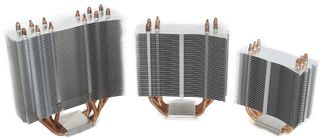
Really, this is the first time we've rounded up heat sinks from one vendor, comparing different sizes from the same line, rather than narrowing down one configuration from as many companies as possible. Thomas is going to continue with that more traditional approach for us, but the Tom's Hardware Germany team plans to fill out our CPU Cooling Charts with these vertical comparisons, too. For this first exploration, we're looking at Thermalright's True Spirit 140(BW), 120M(BW) and 90M.
Packaging and In The Box
The True Spirit 140(BW) comes in a blue-and-black package, while the 120M(BW) and 90M ship in yellow-and-black packaging. The heat sinks are protected by sponge foam, and the accessories are in their own small cardboard box next to the coolers.

The bundles for all three coolers are almost completely identical. There’s a universal back plate accommodating current AMD and Intel processor interfaces, a universal retention frame for the sink, and the hardware you need to secure the plate, frame, and cooler. If you've ever used Thermalright's Macho solutions, you'll already be familiar with the configuration process. Each cooler also includes a well-illustrated installation manual. What's more, Thermalright includes a small 2 g bag of its own “Chill Factor” thermal paste.

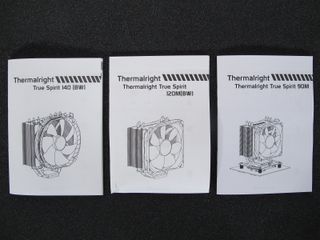
The only differences you'll notice between the coolers' accessories are related to fan mounting. Not only do the bundled fans sport dissimilar diameters (140, 120, and 92 mm), but the larger coolers include retention clips for two 140 or two 120 mm fans, whereas the smaller 90M only comes with clips for the included 92 mm fan.
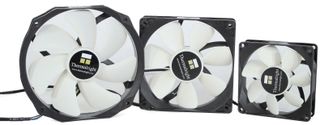
Vibration isolation is a bit different too. Thermalright's 140(BW) employs two large rubber pads that are glued to the cooler itself, whereas the 120M(BW) and the 90M only get two thin rubber strips.
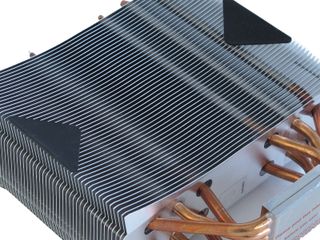
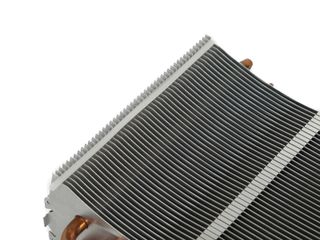
Current page: Thermalright’s True Spirit Line
Next Page Technical Specifications And DesignStay on the Cutting Edge
Join the experts who read Tom's Hardware for the inside track on enthusiast PC tech news — and have for over 25 years. We'll send breaking news and in-depth reviews of CPUs, GPUs, AI, maker hardware and more straight to your inbox.
-
expl0itfinder I would love to see this compared against a wider selection of air coolers. For instance, the Cooler Master Hyper 212, or other fan favorites. Comparing it to 1 or 2 other brands does not give us a lot to look at.Reply -
Novuake A single other well known cooler for reference would have been great for easy context.Reply
Not all sites and reviews used Delta temps.
Nice review but kind of renders it moot for comparison out of the Silverstone and THermalright Scope. -
Someone Somewhere I think you got a bit lost on your graphs. At a guess, you meant to have one as distance from ambient, and one as absolute, or possibly there's idle readings.Reply
Also, please stick to the same units.
More comparisons would have been nice. -
SpadeM There are a few issues /omissions in the article, first being that the motherboard cap is only used on 939 sockets (i did an install for 970A-D3 AM3+ and it didn't require it) also the anchoring plate is flawed in my opinion because the screw holes that hold it in place aren't actually holes, but more live grooves on the outside of the plate and so the screws actually hold the plate in place with only half of their screw cap. And finally, for users that aren't experienced with multiple cpu heatsinks, tightening the final plate that locks the cooler in place ca very well damage your processor since there's no limiter in place.Reply
Other then that, those are some fantastic coolers, even though the thermal probe on FX-8350 under windows gives me flawed measurements in idle, under load it's quite good. -
iam2thecrowe 2000 rpm is noisy? i used to have a 6000rpm fan on my old athlon xp....... I think people these days are too picky about noise.Reply -
Someone Somewhere Reply11299459 said:2000 rpm is noisy? i used to have a 6000rpm fan on my old athlon xp....... I think people these days are too picky about noise.
Diameter has a lot to do with it - it's more to do with tip velocity than actual RPM. Your fan was likely about 40-50mm.
I've got 40mm fans that are near silent at 3K RPM. You can get 40mm fans that do 13K. -
ubercake Whether it's the motherboard or the heat sink manufacturers... We're still seeing 3rd-party CPU heat sinks and their fans blocking RAM slots for a decade. There's not much innovation going on here. I would tend to think the heat sink manufacturers need to accommodate the current motherboard designs. If they could solve that part of it in a full-size effective heat sink solution, innovation will have taken place. Until that time we'll keep seeing copper this; nickel-plated that; aluminum fins here; heat pipes there; one fan on this one; two fans on that.Reply
Same old stuff; different day. -
Myrkvidr @Someone Somwhere: Sorry, there's a copy&paste issue in the 2nd and 4th chart on page5: It should say "CPU temperature at 20°C ambient" while the 1st and 3rd chart are Delta temps.Reply
@SpadeM: Seems like I just did not RTFM close enough ;) But the measurement results were not affected by using or not using the plastic cap (I ran two separate measurement series). The anchoring plate is sitting very tight - I installed a lot of Thermalright heatsinks during the past couple of weeks. The contact pressure between the True Spirit heatsinks and the CPU is not excessively high, so it shouldn't cause any damage to the CPU.
@all: We just startet off with the new system for CPU cooler testing and had to start somewhere - there will be more results and coolers coming soon :)
